|
This week's practice is based on finding comfort in the physical body (anamaya kosha), ease in the breath (pranamaya kosha), and the ability to witness the mind and emotions (manomaya kosha) in order to get quiet enough to hear the wisdom that lies within (vijnanamaya kosha). These three mudras are based on Jnana Mudra which holds the index and thumb together to awaken your highest wisdom. 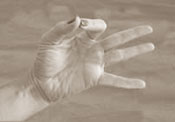 Jnana Mudra Touch the tips of thumb and index fingers together, extend middle, ring and little fingers; rest backs of hands on thighs. Benefits: Helps with concentration and meditation, helps to calm circular thoughts Practice Tips: Use when suffering from "monkey mind" 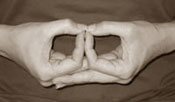 Dhyana Mudra Touch tips of thumbs and index fingers together. Bring right and left hands together and place right middle, ring and pinkie fingers on top of left middle, ring and pinkie fingers. Benefits: Encourages meditative state  Dharmachakra Mudra Touch tips of thumbs and index fingers together. Hold hands in front of chest, left palm facing heart, right hand facing out. Touch right thumb and index to left middle finger. Benefits: Balances energy of inner world with that of the outer world Practice Tips: Use when you are spending too much energy externally or too much internally.
0 Comments
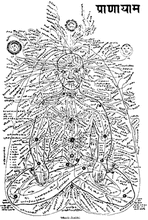 The energetic body, or pranamaya kosha, and the mental/emotional body, or manomaya kosha, make up two of the subtle sheaths that are easily affected by stress, illness and injury. Below you will find a very gentle practice to move the attention inward, away from external stressors to enable you to find peace and calm. 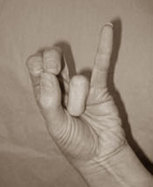 Mahasirs Mudra Curl ring finger into palm; bring together tips of thumb, index & middle fingers; extend the little finger. Rest hands with palms up. Benefits: Draws energy down from head, draws awareness inward Practice Tips: Use when you have head congestion or over-active thoughts 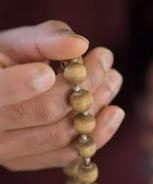 Mantra and Mala A mala is a set of 108 prayer beads that are used to count the recitation of a mantra or sound. Many different mantras may be used but in this meditation we will focus on repeating the mantra A-HAM which means "I am". Hold the mala over your middle finger with the thumb being used to draw the beads toward the body. You do not count the larger tasseled bead, called the meru. For each recitation of A-HAM, count off another bead until you reach the meru bead again. As you work with the mantra and mala, dissolve all of your awareness into the movement of the fingers, the feel of the beads, the sound you are making and the vibration of the sound inside of the body to bring a calmer state to the energetic and mental/emotional bodies. 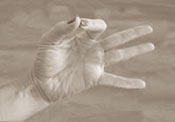 Mantra & Finger Counting If you do not have access to a mala, you may use your fingers in order to count to 108. You will count to twelve on your dominant hand using your thumb as the counting finger. Each of the long fingers has three bones (tip, center and base) and we will count each of these segments to make twelve (4 fingers x 3 segments = 12). With the other hand you will keep track of the sets of twelve in the same pattern. Once nine sets of twelve have been counted, you will have reached 108. Begin with the thumb touching the end of the index finger on both hands. With the dominant hand begin counting in the following pattern moving down one finger and up the next like so: 1 - thumb on index finger tip 2 - thumb on index finger center 3 - thumb on index finger base 4 - thumb on middle finger base 5 - thumb on middle finger center 6 - thumb on middle finger tip 7 - thumb on ring finger tip 8 - thumb on ring finger center 9 - thumb on ring finger base 10 - thumb on pinkie finger base 11 - thumb on pinkie finger center 12 - thumb on pinkie finger tip When you get to thirteen, move the non-dominant hand to position #2, the thumb on the index finger center where it will remain while you use your dominant hand to count 13-24 in the pattern above. Continue to count until nine sets of twelve have been counted and the non-dominant hand will be on the base of the ring finger. The koshas or sheaths, are layers of our being that make up the totality of who we are body, mind and spirit. There are five of these sheaths that organize our being into different levels through which we can attain optimal health and happiness. It is a way of understanding how both health and illness can affect not just the physical body, organs and systems, but also the energy, emotions and mental states as well. For example, when we do yoga asanas, we are moving the physical body, we are breathing more deeply, our mind and emotions are clear, we are quiet to receive intuitive thought and we are attaining glimpses of our utmost selves. Different yogic and other practices will affect different koshas but a change made on one level will be made subtly on all levels. When we are affected by a disease such as cancer, the four outer koshas are also affected. The body may be in pain, the energy suffers, the mind and emotions are in turmoil and we may be less closely in touch with our innate knowing due to the stress and worry of dealing with the disease. Only the inner most sheath is immune to the affects of disease. This core of who we truly are, the Atman, remains unblemished and untarnished by any disease or injury, whole and perfect and always present. Anamaya Kosha (Physical Body) The outer most sheath is the physical body comprised of the muscles, bones, skin, hair, blood vessels and organs. This is where we usually first notice illness and injury in the body because we spend the majority of our time focused on the sensations arising from the body. Practices that Nourish: Eating whole healthy foods, asana and other forms of physical exercise Pranamaya Kosha (Energy Body) The second outermost sheath is the energetic or pranic body comprised of our nervous system, our internal battery, the aura, and the prana within our cells. We are aware of our pranic body usually when we feel particularly energetic or fatigued. Practices that Nourish: Pranayama, mudra, and getting enough sleep PRACTICE FOR THE PHYSICAL & ENERGETIC BODIES:  Whole Body Yoga Series During times of high stress or injury our prana may not reach all places in the body optimally. This simple sequence that moves every part of the body enables you to experience the connection between the physical and energetic bodies first hand. It also distributes prana evenly throughout the whole body to encourage optimal health and well-being. - Whole Body Yoga Series  Vayu Mudra Fold index finger down to base of thumb and hold it in place with the thumb. Rest backs of hands on knees. Benefits: Activates the flow of prana in the body Practice Tips: Use when fearful, anxious, for low immunity, or with arthritis Body Scan Lie down in Savasana and move your awareness to different parts of your body systematically. Feel each part of your body but do not move any part. The practice begins on the right side. Right hand thumb … 2nd finger … 3rd finger … 4th finger … 5th finger … palm of the hand … back of the hand … wrist … forearm … elbow … upper arm … shoulder … armpit … waist … hip … thigh … knee … calf … ankle … heel … sole of the foot … top of the foot … right big toe … 2nd toe … 3rd toe … 4th toe … 5th toe. Left hand thumb … 2nd finger … 3rd finger … 4th finger … 5th finger … palm of the hand … back of the hand … wrist … forearm … elbow … upper arm … shoulder … armpit … waist … hip … thigh … knee … calf … ankle … heel … sole of the foot … top of the foot … left big toe … 2nd toe … 3rd toe … 4th toe … 5th toe. No go to the back of the body … right heel … left heel … right calf … left calf … right thigh … left thigh … right buttock … left buttock … lower back … middle back … upper back … the entire spine … right shoulder blade … left shoulder blade … back of the neck … back of the head. Top of the head … forehead … right temple … left temple … right ear … left ear … right eyebrow … left eyebrow … middle of the eyebrows … right eye … left eye … right nostril … left nostril … right cheek … left cheek … upper lip … lower lip … both lip together … chin … jaw … throat … right collarbone … left collarbone … right side of the chest … left side of the chest … upper abdomen … navel … lower abdomen … right groin … left groin … the pelvic floor. The whole right leg … whole left leg … whole right arm … whole left arm … the whole face … the whole head … the whole torso … the whole body … the whole body … the whole body. |
Index:Archives:
September 2022
I attend Cheryl's class regularly and feel that my practice has improved immensely over the past few years due to her expert coaching. Her teaching style is clear and compassionate and her previous experience in teaching adults is evident in her organized approach and easy to understand instructions. I also appreciate that Cheryl not only teaches us about how to correctly position ourselves, but also touches on many aspects of yoga philosophy, which in turn has deepened my personal practice and heightened my awareness of the connection between mind and body, breath and relaxation. |

 RSS Feed
RSS Feed
